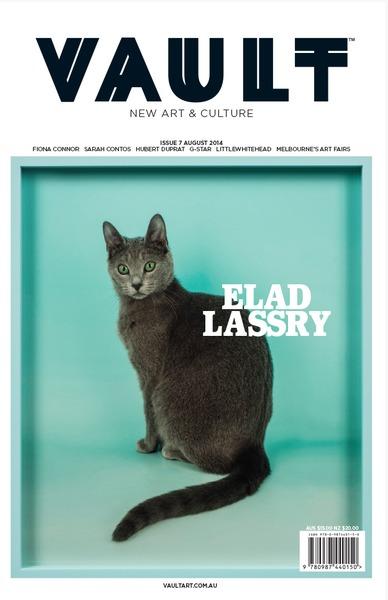First published in Vault issue 7, August 2014
New York Fashion Week, an event that owes its existence to the power of spectacle, is the last place you’d expect to see the ghost of Guy Debord. But when Dennis Hopper recited Rudyard Kipling’s poem “If” during a 2008 show by Dutch denim label G-Star RAW, the French visionary – whose belief in the value of dissolving boundaries between disciplines has shaped everything from punk acts like the Sex Pistols to anti-consumerist organisations such as Adbusters – announced his presence in the status-crazed world of high fashion.
“G-Star wanted a celebrity on the catwalk and I thought, instead of going with a young, hot Hollywood star we should choose Dennis Hopper, a 72-year old actor who is a legend,” laughs Shubhankar Ray, whose 2006 appointment as G-Star’s global brand director saw the label, which was founded in Amsterdam in 1989, leapfrog from obscurity into the cultural consciousness. “Dennis and I constructed an idea that was about an art hijack in the middle of a fashion show, which is no-one had done before. I got lucky in because he invited me to his house to make the idea and we decided that it would focus on poetry.”
At G-Star’s Sydney headquarters, a gleaming white-and-steel space that could have been lifted from the Jetsons, it’s impossible to tell whether or not you’re being swallowed by one of the interventions that made Ray an unlikely posterboy for anti-fashion. Stylists, photographers and publicists orbit around taxidermic jeans displays and grainy footage of the brand’s latest campaign flickers across a far wall. As the supermodel Lily Cole, who stars in the campaign alongside chess great Magnus Carlsen, strides towards the elevator, retracting doors confirm that she isn’t, in fact, a hologram. At one point Ray, who manages the difficult feat of making double denim look like a style triumph, hands me a notebook plastered with sketches and polaroids. “Denim is a universal fabric but we want to elevate it to art level. That’s why we train our designers to look outside the world of fashion.”
Ray’s introduction to this world came in the form of an early brush with a defining cultural moment – the post-punk scene in mid-eighties Manchester. “I was studying chemistry at university in Manchester during a time where the city was producing a lot of pop culture,” Ray recalls. “This was the time of New Order, the Smiths, Stone Roses, Happy Mondays. I started writing music reviews for the local newspaper, mainly because I could get into gigs for free. I then started working for New Order, collecting glases in their nightclub.”
It wasn’t long before Ray’s creative awakening clashed with his career plans. “When you come from a very traditional academic Indian family, you only have the choice of doing medicine or science,” says Ray, who was born in Calcutta in the late sixties. “So I went off to become a research scientist but became disillusioned – they didn’t want me to quit so they offered me an MBA. The science facility was funded by Nestle and I found myself on secondment in a marketing function, where we made 45 TV commercials with the world’s best agencies. I fell into a marketing job at Levi’s by accident.”
Although Ray went on to channel a love of street photography into a long-running campaign for Caterpillar, it was his six-year stint as creative director of Camper – a family-run footwear brand established in Majorca, Spain in 1877 – that saw him hone his distinctive aesthetic. “With Camper, I was able to use interventions to create a more socially progressive brand,” explains Ray, who enlisted Stefan Ruiz, the creative director of Benetton’s legendary Colors magazine, to create hyper-saturated images of Mediterranean farm life with slogans that urged audiences to reject the rat race and slow down. Ray, whose work has been shown at London’s Design Museum, the Venice Biennale and Barcelona’s Centre for Contemporary Culture, also created The Walking Society, a publication that helped attract the 2004 Cannes Cyber Lion award and shares DNA with the work of Colors creators Olivier Toscani and Tibor Kalman. “I cast old people and things that weren’t considered cool,” Ray explains. “This wasn’t about New York, London or Paris, it was about a world that had never been seen before. It was very much about taking the ordinary and showing the ways in which it is extraordinary.”
At G-Star, Ray is less in the business of advertising than he is in exploring the ways in which democracy can galvanise a brand. In 2010, he launched RAW Nights, a virtual nightclub in Tokyo that saw Japanese photographer Hiromix play reggae while Mark Newson rolled rice mochi on stage. Ray, who positions G-Star in the utilitarian realm of industrial design rather than the fickle world of fashion, has also conceived a range of hoodies with Newson, collaborated with Leica and worked with Swiss manufacturer Vitra to reinterpret classic pieces by Modernist furniture icon Jean Prouvé.
“Our crossovers are about mishmashing high and low culture and stripping away hierarchies,” he says. “It’s about making products with a high life expectancy and in that sense, denim has more in common with products such as furniture. The objects that Mark Newson makes are expensive but the pieces we created with him are accessible and feature minimised seams rather than heavy construction. We work with people with a similar mindset – maniacal dedication to product innovation, technology and quality.”
Unsurprisingly, it was Anton Corbijn, whose stark images transplanted bands such as Joy Division and Depeche Mode into the collective memory, who best vocalised G-Star’s visual language. Ray attributes the success of the four-year collaboration – which saw Corbijn shoot Liv Tyler, Benecio Del Toro and Vincent Gallo in G-Star denim – to the photographer’s talent for transforming celebrities into characters and allowing the product to take centre stage.
Ray owes his own trajectory to an ability to mine the power of suggestion and forge partnerships that combine relevance with surprise. For Spring 2014, the brand asked Lily Cole – a multi-hyphenate model who holds a double-first from Cambridge– to front a chess-inspired print and TV campaign alongside Magnus Carlsen. “Lily matches our Brand DNA – she’s an actress, model and activist,” says Ray. “She fits the idea of raw elegance which is part of the feminine side of a brand and she’s an unusual commodity as she’s doing stuff you don’t expect a model to do.”
It’s a descriptor that equally befits Ray. Although G-Star, which generates revenue upwards of $US1 billion and created the Elwood, the world’s second biggest-selling pair of jeans after Levi’s 501, it’s also a study in the surprising symbiosis between commerce, creativity and sustainability.
“We started making sustainable products in 2008 after working with the United Nations to amplify millennium-related goals,” says Ray, who recently partnered with Pharell William’s company Bionic Yarn, as part of a plan to produce jeans out of recycled bottles. “We were manufacturing with organic cotton, nettle and recycled materials but in 2010, we aggregated all of our fabrics and started using sustainable materials across all our biggest selling jeans and shirt styles. We produce in low-labour cost countries such as China and India so we have to make sustainability a condition of doing business rather than a byproduct.”
He pauses for a moment as if to reassess his own motives. “If we really are a brand driven by innovation, we have to make the right choices while having the biggest impact on the market.”

